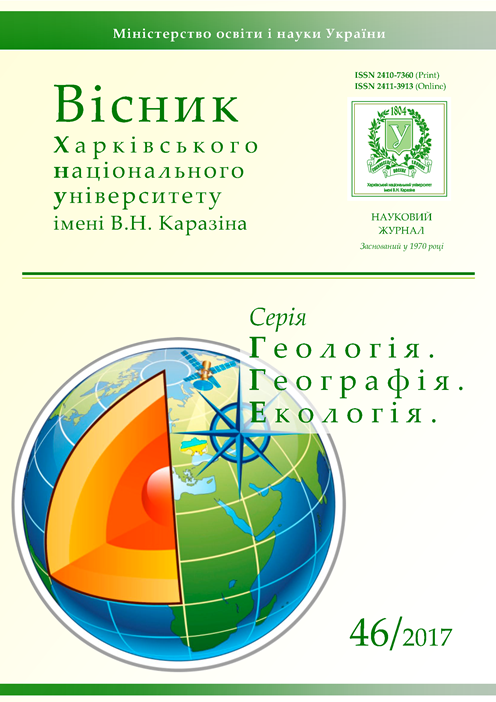Оціночно-прогностичне моделювання геодемографічної системи Харківського регіону
DOI:
https://doi.org/10.26565/2410-7360-2017-46-19Ключові слова:
населення, геодемографічна система, моделювання, оціночно-прогностична модель, Харківська областьАнотація
Подано загальний алгоритм оціночно-прогностичної моделі з позиції суспільно-географічної концепції геодемографічної системи регіону. Для опису зміни стану геодемографічної системи використовується балансове рівняння, яке описує кожне поселення або локальну геодемографічну систему у складі регіональної геодемографічної системи. За результатами моделювання на кожний рік прогнозного періоду (20 років) розраховувалися кількість населення у всіх об’єктах, розподіл населення за віковими групами, середній вік населення, кількість мігрантів за кожною віковою групою, інформаційна ентропія для кожного об’єкту і для кожної вікової категорії. На моделі відтворювались три варіанти сценарію розвитку регіональної геодемографічної системи: зі збереженням поточних (на початок 2016 року) параметрів руху населення, оптимістичний (зі зростанням народжуваності та міграційної активності) та середній (зі збільшеною народжуваністю). Висвітлено результати моделювання за трьома сценаріям та з огляду на одно-, дво-, трьох- та чотирьох центричний просторовий розвиток регіону. Визначені показники чисельності та складу населення міст Харків, Куп’янськ, Ізюм та Лозова. Оціночно-прогностична модель геодемографічної системи регіону є універсальним інструментом дослідження та соціального управління і може використовуватися для вирішення найрізноманітніших задач. Окреслені можливості застосування оціночно-прогностичної моделі для управління розвитком геодемографічної системи регіону.
Посилання
Nyemets', K., Sehida K., Nyemets', L. (2016). Bahatovymirnyy analiz u suspil'niy heohrafiyi (netradytsiyni metody) [Multivariate analysis in social geography (alternative methods)]. Kh. : KhNU imeni V. N. Karazina, 120.
Nyemets', K. A., Nyemets', L. M. (2013). Prostorovyy analiz u suspil'niy heohrafiyi: novi pidkhody, metody, modeli [Spatial analysis in human geography: new approaches, methods, models]. Kharkiv, Kharkivs'kyy natsional'nyy universytet imeni V. N. Karazina, 228.
Sehida, K. (2017). Heodemohrafichna systema yak funktsional'na pidsystema sotsioheosystemy [Geodemographical system as functional subsystems of sociogeosystem]: 2017 internet conference. Trends and prospects of development of science and education in terms of globalization. Pereyaslav-Khmelnytsky (Ukraine), 394, 6-10.
Strategy of the Kharkiv region till 2020. Available at : kharkivoda.gov.ua/documents/16203/1088.pdf.
Chmykhalo, M. L. Ed (2003). Kharkivs'ka oblast' u 2002 rotsi [Kharkiv region in 2002]. Kharkov, VD «INZhEK», 604.
Chmykhalo, M. L. Ed (2004). Kharkivs'ka oblast' u 2003 rotsi [Kharkiv region in 2003]. Kharkov, PP «KrymArt», 643.
Chmykhalo, M. L. Ed (2005). Kharkivs'ka oblast' u 2004 rotsi [Kharkiv region in 2004]. Kharkov, TOV «Zoloti storinky», 608.
Chmykhalo, M. L. Ed (2006). Kharkivs'ka oblast' u 2005 rotsi [Kharkiv region in 2005]. Kharkov: TOV «Zoloti storinky», 606.
Chmykhalo, M. L. Ed (2007). Kharkivs'ka oblast' u 2006 rotsi [Kharkiv region in 2006]. Kharkov, TOV «Zoloti storinky», 562.
Chmykhalo, M. L. Ed (2008). Kharkivs'ka oblast' u 2007 rotsi [Kharkiv region in 2007]. Kharkov, Holovne upravlinnya statystyky u Kharkivs'kiy oblasti, 590.
Chmykhalo, M. L. Ed (2009). Kharkivs'ka oblast' u 2008 rotsi [Kharkiv region in 2008]. Kharkov, Holovne upravlinnya statystyky u Kharkivs'kiy oblasti, 578.
Nikiforova, O. S. Ed (2010). Kharkivs'ka oblast' u 2009 rotsi [Kharkiv region in 2009]. Kharkov, Holovne upravlinnya statystyky u Kharkivs'kiy oblasti, 586.
Mamontova, O. H. Ed (2011). Kharkivs'ka oblast' u 2010 rotsi [Kharkiv region in 2010]. Kharkov, Holovne upravlinnya statystyky u Kharkivs'kiy oblasti, 568.
Mamontova, O. H. Ed (2012). Kharkivs'ka oblast' u 2011 rotsi [Kharkiv region in 2011]. Kharkov, Holovne upravlinnya statystyky u Kharkivs'kiy oblasti, 583.
Mamontova, O. H. Ed (2013). Kharkivs'ka oblast' u 2012 rotsi [Kharkiv region in 2012]. Kharkov, Holovne upravlinnya statystyky u Kharkivs'kiy oblasti, 535.
Mamontova, O. H. Ed (2014). Kharkivs'ka oblast' u 2013 rotsi [Kharkiv region in 2013]. Kharkov, Holovne upravlinnya statystyky u Kharkivs'kiy oblasti, 492.
Mamontova, O. H. Ed (2015). Kharkivs'ka oblast' u 2014 rotsi [Kharkiv region in 2014]. Kharkov, Holovne upravlinnya statystyky u Kharkivs'kiy oblasti, 540.
Mamontova, O. H. Ed (2016). Kharkivs'ka oblast' u 2015 rotsi [Kharkiv region in 2015]. Kharkov, Holovne upravlinnya statystyky u Kharkivs'kiy oblasti, 534.
##submission.downloads##
Опубліковано
Номер
Розділ
Ліцензія
Авторське право (c) 2017 К. Ю. Сегіда

Ця робота ліцензується відповідно до Creative Commons Attribution 4.0 International License.
Автори, які публікуються у цьому журналі, погоджуються з наступними умовами:- Автори залишають за собою право на авторство своєї роботи та передають журналу право першої публікації цієї роботи на умовах ліцензії Creative Commons Attribution License, котра дозволяє іншим особам вільно розповсюджувати опубліковану роботу з обов'язковим посиланням на авторів оригінальної роботи та першу публікацію роботи у цьому журналі.
- Автори мають право укладати самостійні додаткові угоди щодо неексклюзивного розповсюдження роботи у тому вигляді, в якому вона була опублікована цим журналом (наприклад, розміщувати роботу в електронному сховищі установи або публікувати у складі монографії), за умови збереження посилання на першу публікацію роботи у цьому журналі.
- Політика журналу дозволяє і заохочує розміщення авторами в мережі Інтернет (наприклад, у сховищах установ або на особистих веб-сайтах) рукопису роботи, як до подання цього рукопису до редакції, так і під час його редакційного опрацювання, оскільки це сприяє виникненню продуктивної наукової дискусії та позитивно позначається на оперативності та динаміці цитування опублікованої роботи (див. The Effect of Open Access).





